Are Baby Chickens in the Eggs We Eat
Why Do Hens Lay Unfertilized Eggs?
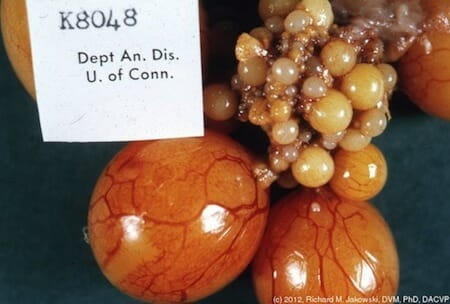
Hens ovulate for the same reason female person humans do: to reproduce. In chickens, the ovary is a cluster of developing ova, or yolks. Female person human ovaries also contain developing eggs. In women, a mature egg is released from the ovary in one case a calendar month. If the egg becomes fertilized, it attaches to the wall of the uterus and begins to form an embryo. If the egg is not fertilized, information technology is eliminated. This happens roughly two weeks before menstruation (the shedding of the uterine lining), a process which exacts a heavy toll on the female body. Although chickens do not menstruate (and thus their eggs are not "chicken periods" as is sometimes asserted), the cycle of creating and passing much larger eggs relative to their body size and weight is arguably even more physically taxing, especially in modern hens who accept been bred to produce such unnaturally high rates of eggs.
How Many Eggs Do Chickens Lay?
In fact, the procedure of making and passing an egg requires so much energy and labor that in nature, wild hens lay only 10 to 15 eggs per year. (1, ii) The Red Jungle Fowl — the wild relatives from whom domestic layer hens are descended — lay 1 to two clutches of eggs annually, with 4 to 6 eggs per clutch on average. (3) Their bodies could never sustain the physical depletion of laying the hundreds of eggs that domestic chickens have been forced to produce through genetic manipulation. Information technology is a common misconception that chickens are always just naturally "giving" eggs, considering mod egg hens take been intensively bred to lay between 250 to 300 eggs a year. Only in the wild, chickens, like all birds, lay only during breeding season — primarily in the bound — and simply enough eggs to clinch the survival of their genes.
Are Eggs Expressionless Baby Chicks?
Non technically, since eggs sold for human consumption are unfertilized, but the egg manufacture kills millions of newborn baby chicks every unmarried day; more 260 million are killed every yr in the U.S. alone. (four) At the hatcheries that supply female chicks to factory egg farms, small farms, and backyard egg hen enthusiasts, male chicks are sorted and killed shortly afterward nascence by being ground upwards alive in giant macerators, gassed, or left to suffocate in garbage bags and dumpsters. Because male chicks will never lay eggs and are not the brood sold for meat (meat chicken breeds take been genetically manipulated to grow much more breast muscle and flesh), they are considered worthless to the egg industry, then are disposed of as trash. Destroying male chicks is standard egg industry practice worldwide (see the short graphic video below). Even the nearly rigorous humane labeling certification programs in the U.S., Certified Humane, American Humane Certified, and Animal Welfare Canonical, let the killing of male chicks at the hatcheries which supply their egg farms with laying hens. (5)
For more than on hatcheries, please visit Mercy for Animals.
The Labor Intensive Process of Creating Eggs
It takes 24-26 hours for a hen to internally construct an egg (adding the albumen, shell membranes and beat). One time a yolk is fully developed, it is released from the ovary into the oviduct, a long, convoluted tube made up of five different sections: the infundibulum or funnel; the magnum; the isthmus; the uterus or beat gland; and the vagina. Each of these sections is like a station along an assembly line and is responsible for a specific stage of egg formation.
The first stop is the infundibulum, a 3-4 inch long muscular portion of the oviduct which engulfs the ovum, or yolk, released from the ovary. The ovum remains in the infundibulum for xv to 18 minutes, and information technology is here where fertilization would occur if the hen mated with a rooster. Yet, eggs sold for human consumption are not fertilized (most egg-laying hens never even have a chance to mate.)
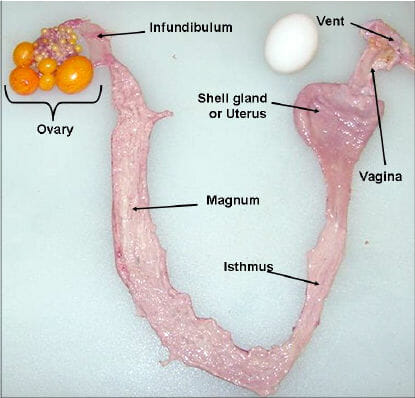
The next stage of egg structure occurs in the magnum, the largest section of the oviduct at 13 inches long. The ovum, or yolk, stays in the magnum for three hours while the albumen, or "egg white," is added. The third stop is the isthmus, a constricted portion of tissue where the inner and outer shell membranes of the developing egg are added over a menstruum of 75 minutes.
The longest stage of egg product occurs in the beat out gland or uterus. This is where the crush is deposited around the egg, which takes 20 plus hours. Egg shellsare more often than not made of calcium carbonate, and for each shell produced, the hen must mobilize approximately 10% of the calcium stored in her bones. This is a main reason egg-laying hens are and then commonly affected with debilitating osteoporosis, as the almost constant product of an unnatural quantity of eggs depletes their bodies of massive amounts of calcium.
The last finish in egg product is the vagina. This is where a sparse outer coating of mucus, called the cuticle or bloom, is added to the shell. The vagina too pushes the egg out through the vent or cloaca, the shared exit through which urine, carrion, and eggs are excreted.
Eggs and the Touch of Laying on Chicken Health
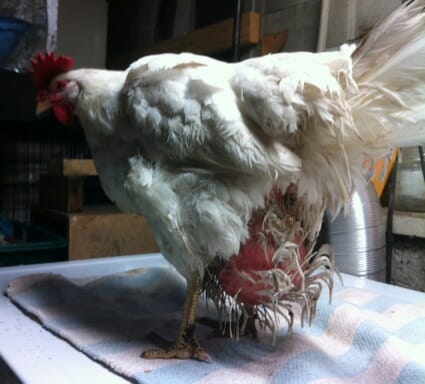
The unnaturally high rates of labor intensive, energy depleting egg production that modern hens are forced to sustain ways that even on minor farms and backyard craven operations, hens are virtual prisoners within their own bodies. Overproduction of eggs is responsible for numerous disorders in hens, including often fatal diseases of the reproductive tract; osteoporosis and accompanying os fractures; and, in some cases, total skeletal paralysis, sometimes referred to as "caged layer fatigue." Osteoporosis and bone fragility from unnatural lay rates are also profoundly exacerbated by lack of exercise: more than 95% of egg laying hens in the U.S. spend their unabridged lives confined in battery cages so small they cannot even spread their wings. (5) By the fourth dimension hens reach the slaughterhouse at 18 months to 2 years of historic period, their wing and leg basic are frequently riddled with painful breaks.
Reproductive disorders in egg laying hens include tumors of the oviduct; peritonitis; egg binding (large eggs getting stuck and existence dull and painful to pass); and uterine prolapse, a condition in which the lower portion of the oviduct fails to retract back into the body afterward oviposition, or the depositing of an egg. Similar egg binding, prolapse is commonly a result of small birds existence genetically manipulated to lay an unnaturally loftier rate of unnaturally large eggs.
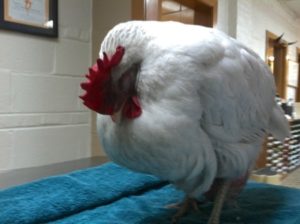
Sweet Pea was a cherished Complimentary from Impairment rescue with an incredibly sweet disposition and tremendous zest for life. She developed several acute episodes of egg yolk peritonitis, a common disorder and frequent crusade of death in egg laying hens. Egg yolk peritonitis results from egg yolks diverting into the abdominal cavity of hens, or from rupture or lodging of thin-shelled or otherwise malformed eggs in the oviduct. (Thin-shelled eggs are mutual in layer hens because the birds do non have sufficient calcium stores to produce such a high rate of shells). When eggs interruption or yolks accrue within of hens, this leads to a build-up of rotting egg material in the oviduct and abdomen, which causes painful swelling and frequently fatal bacterial infection. Despite the best veterinary treatment, Sugariness Pea suffered in her final days before succumbing to this mutual killer.
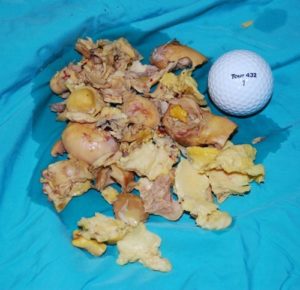
Dr. Peter Sakas, the veterinarian who treats all of Free from Harm's rescued chickens, recently sent us this image (left) after surgically removing more than than i pound of rotting egg cloth from the uterus of some other hen. He writes:"This is something we see so ordinarily with hens: reproductive tract complications, egg bounden, decomposed eggs, egg yolk peritonitis, eggs rupturing through the oviduct, all sorts of bug. It is tragic as some cases are then astringent they can not be corrected, but we try to salvage these wonderful animals!
"We had a hen come in as she was weak, lethargic, and had an enlarged abdomen. She had been a prolific egg layer but had recently stopped. Nosotros hospitalized, stabilized her, and in a few days performed an exploratory surgery. We removed over one pound of decomposed egg material from her oviduct (uterus)."
Jewel Johnson, who rescues chickens at Danzig's Roost in Colorado, wrote to united states of america regarding the engineered overproduction of eggs in laying hens: "I've had two hens die on the operating tabular array. One was found to have fourteen eggs in her. But because one egg gets stuck and cannot be laid, it does not stop her trunk from making another egg the next day, and the next, and the adjacent…"
Beyond Eggs, Across Exploitation
Chickens were only ever domesticated for one reason: to exploit them. All chickens used for meat and eggs are the result of centuries of violent domination and decades of invasive genetic manipulation that dooms fifty-fifty those lucky enough to be rescued to a lifetime of unnatural frailty and illness. This means that all eggs, even those from rescued hens, are the product of injustice. Since humans have no biological need to consume eggs, we can withdraw our support from this exploitative industry past choosing plant-based egg alternatives for baking and cooking. Those who rescue hens can feed their eggs back to these birds, who will typically eat them with great enthusiasm, and grind the shells into their feed to restore much needed calcium.
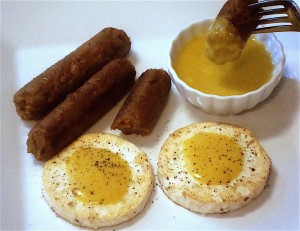
It's Easy and Delicious to Veganize Your Favorite Egg Dishes!
From fluffy omelets to sunny side ups, from savory quiche to crème brûlée, our comprehensive guide to "vegan eggs" showcases incredible recipe creations, mouthwatering photos, and heaps of egg-free blistering tips.
For more than information on the suffering and mistreatment of chickens in the egg manufacture, including little known practices on farms selling "cage-free" and "free range" eggs, please meet our feature on standard egg industry practices.
Meet our entire collection of posts on the subject of eggs and egg laying chickens.
____________________________
(i) University of Kentucky Higher of Agriculture, Food and Environment, Poultry Extension, Small and Backyard Flocks: Oft Asked Questions. Retrieved 2/11/2014 from http://www2.ca.uky.edu/smallflocks/FAQs.html
(two) "Different most domestic hens, who accept been selectively bred to lay eggs year-circular, wild fowl breed and lay primarily in spring. The Blood-red Jungle Fowl lays ten-xv eggs per yr, and the average size of each brood is four-6 chicks." Humane Society of the United States, Most Chickens. Retrieved 2/11/2014 from http://world wide web.humanesociety.org/assets/pdfs/farm/about_chickens.pdf
(3) Encyclopedia of Life, Facts Well-nigh Ruddy Junglefowl. Retrieved 2/11/2014 from http://eol.org/pages/1049263/details
(iv) An HSUS Written report: The Welfare of Animals In the Egg Industry: http://www.humanesociety.org/assets/pdfs/subcontract/welfare_egg.pdf
(5) Rodriguez, Sheila. "The Morally Informed Consumer: Examining Creature Welfare Claims on Egg Labels", Temple Periodical of Science, Technology & Ecology Constabulary, 51 (2011).
(6) An HSUS Report: The Welfare of Animals In the Egg Manufacture: http://world wide web.humanesociety.org/avails/pdfs/farm/welfare_egg.pdf
Source: https://freefromharm.org/eggs-what-are-you-really-eating/
0 Response to "Are Baby Chickens in the Eggs We Eat"
Post a Comment